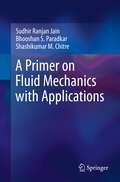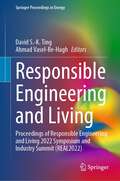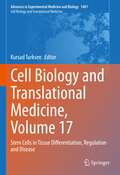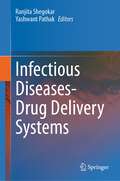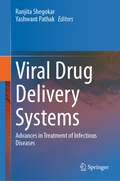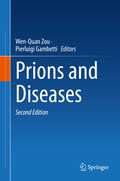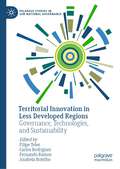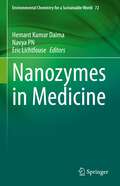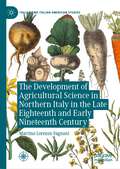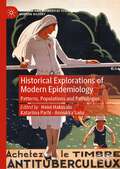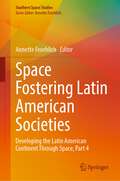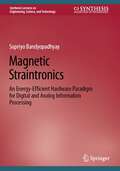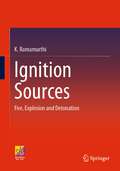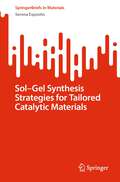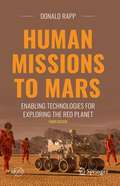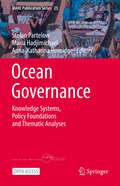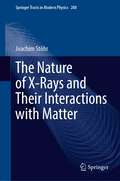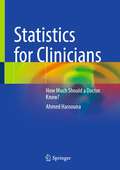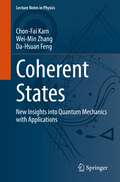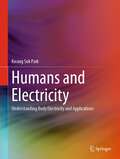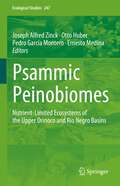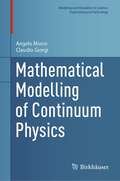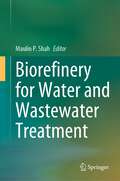- Table View
- List View
A Primer on Fluid Mechanics with Applications
by Sudhir Ranjan Jain Bhooshan S. Paradkar Shashikumar M. ChitreThis textbook is a pedagogic introduction to a number of phenomena employing fluid mechanics. Beginning with basic concepts and conservation laws for neutral and charged fluids, the authors apply and develop them to understand aerodynamics, locomotion of micro-organisms, waves in air and water, shock waves, hydrodynamic and hydromagnetic instabilities, stars and black holes, blood flow in humans, and superfluids. The approach is to consider various striking topics on fluid mechanics, without losing necessary mathematical rigor. The book balances the qualitative explanations with formal treatment, in a compact manner. A special focus is given to the important and difficult subject of turbulence and the book ends with a discussion on turbulence in quantum fluids. The textbook is dotted by a number of illustrative examples, mostly from real life, and exercises. The textbook is designed for a one semester course and addresses students at undergraduate and graduate level in physics or engineering, who want to research in the fields as diverse as aeronautics, meteorology, cosmology, biomechanics, and mathematical physics. It is requested knowledge of an undergraduate level course on mathematical methods to better understand the topics presented here.
Responsible Engineering and Living: Proceedings of Responsible Engineering and Living 2022 Symposium and Industry Summit (REAL2022) (Springer Proceedings in Energy)
by David S.-K. Ting Ahmad Vasel-Be-HaghThis book includes the proceedings of the Responsible Engineering and Living 2022 Symposium and Industry Summit. Molière holds each of us accountable when he asserted that, “It is not only for what we do that we are held responsible, but also for what we do not do.” Responsible Engineering and Living 2022 (REAL2022) strived to inspire every individual to practise and foster responsible engineering and living. Its proceedings brings all stakeholders, enthusiasts and experts from academia, industry, policy arenas, and general public, together to discuss challenges, sharpen existing solutions, and formulate novel means to advance responsible engineering and living. This symposium disseminates recent progress and promote collaborations to maximize opportunities for innovative solutions. Topics of interest include resource and energy conservation, waste reduction, nature-friendly engineering and architecture, and sustainable vibrant living.
Cell Biology and Translational Medicine, Volume 17: Stem Cells in Tissue Differentiation, Regulation and Disease (Advances in Experimental Medicine and Biology #1401)
by Kursad TurksenMuch research has focused on the basic cellular and molecular biological aspects of stem cells. Much of this research has been fueled by their potential for use in regenerative medicine applications, which has in turn spurred growing numbers of translational and clinical studies. However, more work is needed if the potential is to be realized for improvement of the lives and well-being of patients with numerous diseases and conditions.This book series 'Cell Biology and Translational Medicine (CBTMED)' as part of Springer Nature’s longstanding and very successful Advances in Experimental Medicine and Biology book series, has the goal to accelerate advances by timely information exchange. Emerging areas of regenerative medicine and translational aspects of stem cells are covered in each volume. Outstanding researchers are recruited to highlight developments and remaining challenges in both the basic research and clinical arenas. This current book is the 17th volume of a continuing series.
Infectious Diseases Drug Delivery Systems
by Ranjita Shegokar Yashwant PathakThe disability-adjusted life year (DALY) is a generic measure of health effect that can be used in cost-effectiveness analysis as an alternative to the quality-adjusted life year (QALY). Infectious diseases are one of the major to cause significant losses of DALY and QALY. Human infectious diseases are disorders that are triggered by the micro-organisms such as bacteria, fungi, viruses, or parasites. The majority of such diseases are contagious and create a public health menace. There are several reasons why infectious diseases are deadly diseases, and one of the primary reasons is the drug resistance developed over time. Drug resistance-associated mutations are linked to increasing drug efflux, modifications of the drugs, or their targets. Every year, new drugs are being approved by FDA to treat infectious diseases. Nonetheless, the infectious diseases will undoubtedly persist as permanent and main threats to humanity for now and in the future.A total of four books are covered under the series of Infectious drug diseases.- Malarial drug delivery systems- Tubercular drug delivery systems- Viral drug delivery systems- Infectious disease drug delivery systemsInfectious diseases are the world’s greatest killers that present one of the most significant health and security challenges. Humans have lived with emerging and re-emerging pathogens since before the documented history of civilization. The only determining fact today is - If the situation is “worse” or “better” than in past. The answer is probably “worse”, may be due significant increase in human population, increased cross-continent mobility, imbalanced (stressed) life style, irregular food habits leading to compromised innate immunity and over or under practiced hygiene routine. When the incidence of such a disease in people increases over 20 years or threatens to increase, it is called an “emerging” disease, and a growing number have made watch lists and headlines in nearly every country -like highly pathogenic H5N1 avian influenza, severe acute respiratory syndrome (SARS), Ebola virus, food- and waterborne illnesses, and a range of antimicrobial-resistant bacterial diseases TB. This book addresses current and new therapy developments in treating such infectious diseases, updates on finding new drugs, identification of innovative diagnostic methods, understanding of disease research models and clinical trials performances of new treatment modalities.Audiences from a broad range of groups, from researchers, academicians, and public health bodies to regulatory experts, can benefit from the compiled information to learn more about patient needs and current research advances in the field of infectious diseases and related research.
Viral Drug Delivery Systems: Advances in Treatment of Infectious Diseases
by Ranjita Shegokar Yashwant PathakThe disability-adjusted life year (DALY) is a generic measure of health effect that can be used in cost-effectiveness analysis as an alternative to the quality-adjusted life year (QALY). Infectious diseases are one of the major to cause significant losses of DALY and QALY. Human infectious diseases are disorders that are triggered by the micro-organisms such as bacteria, fungi, viruses, or parasites. The majority of such diseases are contagious and create a public health menace. There are several reasons why infectious diseases are deadly diseases, and one of the primary reasons is the drug resistance developed over time. Drug resistance-associated mutations are linked to increasing drug efflux, modifications of the drugs, or their targets. Every year, new drugs are being approved by FDA to treat infectious diseases. Nonetheless, the infectious diseases will undoubtedly persist as permanent and main threats to humanity for now and in the future, primarily due to increased longevity that almost always comes at a cost of impaired immunity.A total of four books are covered under the series of Infectious drug diseases.- Malarial drug delivery systems- Tubercular drug delivery systems- Viral drug delivery systems- Infectious disease drug delivery systemsThe third volume of series is focused on viral drug delivery systems. Typically, virus attaches to the cells (referred as host cell) and releases its DNA or RNA inside the cell. In second stage, virus’s genetic material takes control of the cell and forces it to replicate the virus leading to onset of disease symptoms. DNA class of viruses include Herpes, Papilloma and Adeno viruses. RNA class of viruses include retroviruses, such as HIV immunodeficiency virus and SARS COV – 2 / Corona virus. This book addresses recent developments in viral drug delivery systems. It covers many different aspects of viral infections, ways to treat them using modern drug delivery systems like nano particulate carriers. The choice of viral delivery systems mainly depends upon the type of virus, duration of life cycle, presence of drug resistance, cellular and mucosal interaction of virus, accordingly gene or non-gene drug delivery systems are selected. Besides that, this book also reports global dynamics of viral diseases, future predictions of infection rate, current treatment options, details of drug carriers like nanoemulsions, polymeric nanoparticles, role of biofunctionalization, and phyto-molecules in treatment of viral infections particularly herpes, Covid-19, Ebola, HIV/AIDS, influenza and viral hepatitis.Audiences from a broad range of groups, from researchers, academicians, and public health bodies to regulatory experts, can benefit from the compiled information to learn more about patient needs and current research advances in the field of viral drug delivery research.
Advancement of Metal Oxide Materials for Photocatalytic Application: Selected Strategies to Achieve Higher Efficiency
by Vitaly GurylevThis book investigates applicability of various emerging strategies to improve important properties and features of metal oxide materials that can be used further to advance their photocatalytic and photoelectrochemical performances. The range of discussed strategies includes introduction of intrinsic and extrinsic deficiencies, fabrication of heterojunction and utilizing of metal nanoparticles in the form of deposited or embedded formations. Each of them is addressed as separate case in order to reach full and comprehensive assessment of their most fundamental principles and basics as well as accessing pivotal advantages and disadvantages. Furthermore, additional discussion is dedicated to achieving thorough awareness over methods and experimental protocols that are used to realize them and also probing changes which they induce in electronic and geometrical configurations of metal oxide materials. It is believed that this book might become a valuable addition to extend further current knowledge about photocatalysis and material processing.
Prions and Diseases
by Wen-Quan Zou Pierluigi GambettiTransmissible spongiform encephalopathies (TSE), known as prion diseases, have been recognized for nearly 300 years in animals and almost 100 years in humans. Modern studies, including the protein-misfolding cyclic amplification (PMCA), have greatly advanced our understanding of the pathogenesis of prion diseases and facilitated the identification of new prion diseases in animals and humans. In the second edition of Prions and Diseases, more than 60 leading researchers and clinicians worldwide provide an up-to-date discussion of these unique infectious pathogens and their associated diseases. The book provides up-to-date knowledge about the etiology, pathogenesis, classification, histopathological, and clinical aspects of the full range of animal and human prion diseases. As a result, the book contains by far the most authoritative views about the past, present, and future of prions and prion diseases. The new second edition covers such important emerging topics such as inherited human prion disease, stem-cell models in prion research, human prion disease surveillance, and gene therapy strategies.
Territorial Innovation in Less Developed Regions: Governance, Technologies, and Sustainability (Palgrave Studies in Sub-National Governance)
by Filipe Teles Carlos Rodrigues Fernando Ramos Anabela BotelhoThis book examines the roles of communities in the general framework of territorial innovation, particularly in the context of less developed regions. With a specific focus on Portugal, it offers conceptual improvements that will be of use to other European regions. The book will appeal to scholars and students of regional governance and politics, from public administration to economics, sociology, geography and political science, as well as to practitioners.
Nanozymes in Medicine (Environmental Chemistry for a Sustainable World #72)
by Hemant Kumar Daima Navya Pn Eric LichtfouseThis book reviews the latest advances and biomedical applications of nanozymes, which are artificial nanomaterials exhibiting enzymatic properties similar to natural enzymes, but with less limitations than natural enzymes. Nanozymes display advantages such as facile synthesis, easy surface modification, improved stability, higher catalytic power, and target-specific binding. Nanozymes containing metals, metal oxides, carbon, and metal sulfide are actually used for cancer therapy, biomolecules sensing, bioimaging, disease diagnostics and diabetes management. The book discloses underlying mechanisms, concepts, recent trends, constraints, and prospects for nanomedicine using nanozymes.
The Development of Agricultural Science in Northern Italy in the Late Eighteenth and Early Nineteenth Century (Italian and Italian American Studies)
by Martino Lorenzo FagnaniThe late eighteenth century and subsequent Napoleonic Era witnessed a turning point in the establishment of agricultural science as a well-defined discipline in northern Italy. In this book, Martino Lorenzo Fagnani traces these developments by reviewing the correspondence of naturalists and agriculturists as well as the research plans of universities, academies, societies, institutes, and governments. He explores the establishment of a broad knowledge network encompassing all of Europe while also investigating the reasons behind the exchange of seeds, the establishment of spaces for experimentation such as scientific gardens and experimental fields, and the organization of specialized journals and monographs. This work represents an important contribution to the historiography of Italian agricultural science, filling a significant gap in our knowledge of related developments.
Historical Explorations of Modern Epidemiology: Patterns, Populations and Pathologies (Medicine and Biomedical Sciences in Modern History)
by Heini Hakosalo Katariina Parhi Annukka SailoThis volume explores the history of epidemiology from the mid-twentieth century to the present. Epidemiology has exerted major influence on the way that both infectious and chronic diseases are conceptualized and controlled, and, more generally, on the way that people in modern societies think about health, behavior, longevity, and risk. This collection consists of a series of in-depth analyses of the roots, development, and impact of epidemiological research, illuminating the complex relationship between medical research and data on the one hand, and social and cultural factors on the other. The thematical and geographical scope of the book ranges from indigenous and participant perspectives to the visualization of pandemics, and from Circumpolar North to East Africa. The book identifies significant historical changes and the driving forces behind them, charting forms of science-society interaction that characterize modern epidemiology. Chapter 1 and chapter 4 are available open access under a Creative Commons Attribution 4.0 International License via link.springer.com.
Space Fostering Latin American Societies: Developing the Latin American Continent Through Space, Part 4 (Southern Space Studies)
by Annette FroehlichThis peer-reviewed book presents a comprehensive overview of the role space is playing in enabling Latin America to fulfil its developmental aspirations. Following on from the highly acclaimed Parts 1 to 3, it explains how space and its applications can be used to support the development of the full range and diversity of Latin America societies, while being driven by Latin American goals. The Latin American space sector is currently undergoing a phase of rapid and dynamic expansion, with new actors entering the field and with space applications increasingly being used to support the continent’s social, economic, and political development. All across Latin America, attention is shifting to space as a fundamental part of the continental development agenda, and the creation of a Latin American space agency is evidence of this. Additionally, while in recent years, significant advances in economic and social development have lifted many of Latin America’s people out of poverty, there is still much that needs to be done to fulfil the basic needs of the population and to afford them the dignity they deserve. To this end, space is already being employed in diverse fields of human endeavour to serve Latin America’s goals for its future, but there is still a need for further incorporation of space systems and data. This book will appeal to researchers, professionals and students in fields such as space studies, international relations, governance, and social and rural development.
Magnetic Straintronics: An Energy-Efficient Hardware Paradigm for Digital and Analog Information Processing (Synthesis Lectures on Engineering, Science, and Technology)
by Supriyo BandyopadhyayThis book covers the new field of straintronics, using strain switched nanomagnets for extremely energy-efficient computing, information processing, communication, and signal generation. Based on well-established CMOS technology, traditional electronics have two significant shortcomings: excessive energy dissipation and volatility, which is the inability to retain information after power has been switched off. Straintronics is more energy-efficient and non-volatile (but also more error-prone), allowing it to eclipse traditional electronics in niche areas that are increasingly attracting attention, such as image processing and probabilistic computing, computer vision, machine learning, neuromorphic networks, probabilistic computing, and belief networks. Magnetic Straintronics: An Energy-Efficient Hardware Paradigm for Digital and Analog Information Processing introduces straintronics and the technology's myriad applications for researchers, engineers, and scientists in electrical engineering, physics, and computer engineering.
Ignition Sources: Fire, Explosion and Detonation
by K. RamamurthiThis book discusses the different energy sources bringing about fires, explosions, and detonations in combustibles under different levels of confinement. Focus is on the initiation source for a combustible whether it is a gas, a liquid, or a solid in a given state of confinement. Incidents of oxygen-related fires in hospitals which were particularly evident with increased usage of oxygen therapy for the extremely ill COVID-19 patients in 2021 are discussed with details of formation, accumulation, and dissipation of charges and their discharges leading to fires and explosions. Sympathetic detonations, BLEVE explosions, cook-off tests of combustibles, the inadvertent ignition sources (threats), and their control are discussed. Sporadic Ignition of wildfires in a heat dome augmented by the reflection of expansion disturbances from the interfaces separating media of different acoustic impedances are explored. Spontaneous human combustion, pilot ignition, shock wave ignition, ignition of fuel droplets and conditions under which fires, explosions, and detonations take place are discussed. Different ways of mitigating the inadvertent initiation of explosions and detonations are given at the end.
Encryption and Decryption Algorithms for Plain Text and Images using Fractional Calculus (Synthesis Lectures on Engineering, Science, and Technology)
by Rafael Martínez-Guerra Juan Javier Montesinos-García Juan Pablo Flores-FloresThis book offers an alternative for encrypting and decrypting messages using objects called integer and fractional-order estimators or observers, by means of security codes. The authors first establish the class of observers capable of carrying out this work. Then, the type of observers to treat either the integer or fractional order type and their main characteristics is mentioned. The book also presents an essential property of some systems such as Liouville, which is vital for the encryption and decryption of messages in integer and fractional order nonlinear systems by using the synchronization property of chaotic systems. Finally, it addresses some logistic maps such as Mandelbrot sets including Julia and fractal sets, taking advantage of their characteristics to encrypt or recover messages.
Sol-Gel Synthesis Strategies for Tailored Catalytic Materials (SpringerBriefs in Materials)
by Serena EspositoThis book discusses the synthesis of catalytic materials with improved and tailored functionalities via the sol-gel method. Beginning with a general outline of traditional sol-gel chemistry, the book gradually explores surrounding topics, such as the formation of porous structures, while guiding the overall discussion toward the synthesis of heterogeneous catalysts and focusing throughout on the structure-activity relationship in catalytic materials. Featuring several case studies covering major current industrial applications, the book is an ideal guide for researchers looking to tailor catalytic materials for a specific catalytic process and thus exploiting the versatility of the “traditional” sol-gel method.
Human Missions to Mars: Enabling Technologies for Exploring the Red Planet (Springer Praxis Books)
by Donald RappIn this book, Donald Rapp looks at human missions to Mars from a technological perspective. He divides the mission into a number of stages: Earth’s surface to low-Earth orbit (LEO); departing from LEO toward Mars; Mars orbit insertion and entry, descent and landing; ascent from Mars; trans-Earth injection from Mars orbit and Earth return.A mission to send humans to explore the surface of Mars has been the ultimate goal of planetary exploration since the 1950s, when von Braun conjectured a flotilla of 10 interplanetary vessels carrying a crew of at least 70 humans. Since then, more than 1,000 studies were carried out. This third edition provides extensive updating and additions to the last edition, including new sections, and many new figures and tables, and references.
Ocean Governance: Knowledge Systems, Policy Foundations and Thematic Analyses (MARE Publication Series #25)
by Anna-Katharina Hornidge Maria Hadjimichael Stefan PartelowThis Open Access book on Ocean Governance examines sustainability challenges facing our oceans today. The book is organized into three sections: knowledge systems, policy foundations and thematic analyses. The knowledge produced in the book was catalyzed by the scientific outcomes within the European-funded Cooperation in Science and Technology (COST) network “Ocean Governance for Sustainability – Challenges, Options and the Role of Science”. This network brings together scientists, policy-makers and civil society representatives from 28 nation states to cooperate on ocean governance research. This book offers a compilation of new research material including focused case studies, broad policy syntheses and reflective chapters on the history and current status of knowledge production systems on ocean governance. New research material is presented, although some chapters draw on secondary sources. The book starts with synthetic review chapters from the editors, outlining past and present knowledge systems, addressing how and why ocean governance for sustainability is where it currently stands with critical reflections on existing narratives, path dependencies and colonialist histories. This is followed by chapters addressing, synthesizing and analyzing different legal and policy frameworks for ocean governance both regionally and internationally. At the core of the book are the thematic analyses, which provide focused case studies with detailed contextual information in support of different ocean governance challenges and sustainability pathways around the world. The book concludes with a chapter explicitly targeting students, researchers and policy-makers with key take-away messages compiled by the editors.
The Nature of X-Rays and Their Interactions with Matter (Springer Tracts in Modern Physics #288)
by Joachim StöhrThis book gives a comprehensive account of modern x-ray science, based on the use of synchrotron radiation and x-ray-free electron lasers (XFELs). It emphasizes the new capabilities of XFELs which extend the study of matter to the intrinsic timescales associated with the motion of atoms and chemical transformations and give birth to the new field of non-linear x-ray science. Starting with the historical understanding of the puzzling nature of light, it covers the modern description of the creation, properties, and detection of x-rays within quantum optics. It then presents the formulation of the interactions of x-rays with atomic matter, both, from semi-classical and first-principles quantum points of view. The fundamental x-ray processes and techniques, absorption, emission, Thomson, and resonant scattering (REXS and RIXS) are reviewed with emphasis on simple intuitive pictures that are illustrated by experimental results. Concepts of x-ray imaging and diffractive imaging of atomic and nano structures are discussed, and the quantum optics formulation of diffraction is presented that reveals the remarkable quantum substructure of light. The unique power of x-rays in providing atom and chemical-bond specific information and separating charge and spin phenomena through x-ray polarization (dichroism) effects are highlighted. The book concludes with the discussion of many-photon or non-linear x-ray phenomena encountered with XFELs, such as stimulated emission and x-ray transparency.
Statistics for Clinicians: How Much Should a Doctor Know?
by Ahmed HassounaHow much statistics does a clinician, surgeon or nurse need to know?This book provides an essential handbook to help appraise evidence in a scientific paper, to design and interpret the results of research correctly, to guide our students and to review the work of our colleagues. This title is written by a clinician exclusively for fellow clinicians, in their own language and not in statistical or epidemiological terms.When clinicians discuss probability, it is focussed on how it applies to the management of patients in the flesh and how they are managed in a clinical setting. Statistics for Clinicians does not overlook the basis of statistics, but reviews techniques specific to medicine with an emphasis on their application. It ensures that readers have the correct tools to hand, including worked examples, guides and links to online calculators and free software, enabling readers to execute most statistical calculations. This book will therefore be enormously helpful for many working across all fields of medicine at any stage of their career.
Coherent States: New Insights into Quantum Mechanics with Applications (Lecture Notes in Physics #1011)
by Chon-Fai Kam Wei-Min Zhang Da-Hsuan FengThis book presents the essential ideas of coherent states and provides researchers and graduate students with the necessary tools for various applications of generalized coherent state theory. These applications include areas such as quantum information, quantum phase transitions, quantum many-body systems, quantum chaos, and quantum open systems. The aim of the book is to show how coherent states can be applied to an extensive range of physical systems. The authors provide many exercises at the end of each chapter to enhance the mastery of the subject. Throughout the first seven chapters, only an understanding of elementary quantum mechanics is assumed, and for the last six chapters, some basic knowledge of group theory is requested to follow the arguments.
Humans and Electricity: Understanding Body Electricity and Applications
by Kwang Suk ParkHumans are electric beings. We are managed, monitored, and stimulated electrically. This textbook provides students and practitioners with a solid foundation and understanding of human electricity and the work currently being done to further develop electrical signals for medical purposes and related goals. The book introduces the fundamentals of how biological systems generate electrical signals, covering a wide range of biomedical engineering topics including bioelectricity, biomedical signals, neural engineering, and brain-computer interface. The book is presented in three sections: Part I explains how electrical signals and impulses manage the human body; Part II examines the kinds of electrical signals from the human body and how they are monitored, controlled, and used; Part III looks at clinical use of electrical stimulation toward the human body and how they are being developed for interventions in medicine. The book is also a valuable professional reference for practicing engineers and scientists. Explains humans as electric beings who are managed, monitored, and stimulated electrically;Deals with the electricity of major human organs;Covers a wide range of biomedical engineering topics
Psammic Peinobiomes: Nutrient-Limited Ecosystems of the Upper Orinoco and Rio Negro Basins (Ecological Studies #247)
by Joseph Alfred Zinck Otto Huber Pedro García Montero Ernesto MedinaThe book represents a multidisciplinary approach to understanding soil–landscape–vegetation relationships and, specifically, the ecophysiology of plant communities developing on sandy soils of very low fertility that are subject to seasonal flooding. It provides an overview of the white sand ecosystems within the Amazon basin, and focuses on the forest and herbaceous (meadows) vegetation growing on the dystrophic sandy soils of the upper Negro and Orinoco river basins. Several chapters describe physiographic aspects of the study area using integrated remote sensing and in situ sampling. By doing so they attain a comprehensive description of the origin and evolution of soils and landscapes, an advanced classification of soils, and a mapping of the geographic distribution of psammophilous vegetation. This volume also provides a phytosociological classification of extensive forested areas, and a detailed description of the structure and diversity of little-known herbaceous formations.It targets professionals in the fields of ecology, ecophysiology, geomorphology, soils, vegetation, and the environmental sciences. The information it offers may be of significant use to researchers, protected area planners, and environmental policy makers.
Mathematical Modelling of Continuum Physics (Modeling and Simulation in Science, Engineering and Technology)
by Angelo Morro Claudio GiorgiThis monograph provides a comprehensive and self-contained treatment of continuum physics, illustrating a systematic approach to the constitutive equations for wide-ranging classes of materials. Derivations of results are detailed through careful proofs, and the contents have been developed to ensure a self-contained and consistent presentation.Part I reviews the kinematics of continuous bodies and illustrates the general setting of balance laws. Essential preliminaries to continuum physics – such as reference and current configurations, transport relations, singular surfaces, objectivity, and objective time derivatives – are covered in detail. A chapter on balance equations then develops the balance laws of mass, linear momentum, angular momentum, energy, and entropy, as well as the balance laws in electromagnetism.Part II is devoted to the general requirements on constitutive models, emphasizing the application of objectivity and consistency with the second law of thermodynamics. Common models of simple materials are then reviewed, and in this framework, detailed descriptions are given of solids (thermoelastic, elastic, and dissipative) and fluids (elastic, thermoelastic, viscous, and Newtonian).A wide of variety of constitutive models are investigated in Part III, which consists of separate chapters focused on several types of non-simple materials: materials with memory, aging and higher-order grade materials, mixtures, micropolar media, and porous materials. The interaction of the electromagnetic field with deformation is also examined within electroelasticity, magnetoelasticity, and plasma theory.Hysteretic effects and phase transitions are considered in Part IV. A new approach is established by treating entropy production as a constitutive function in itself, as is the case for entropy and entropy flux. This proves to be conceptually and practically advantageous in the modelling of nonlinear phenomena, such as those occurring in hysteretic continua (e.g., plasticity, electromagnetism, and the physics of shape memory alloys).Mathematical Modelling of Continuum Physics will be an important reference for mathematicians, engineers, physicists, and other scientists interested in research or applications of continuum mechanics.
Biorefinery for Water and Wastewater Treatment
by Maulin P. ShahBio-refinery approach of microbial fermentation, production of biogas, bioenergy, enzymes, bioactive molecules, agricultural nutrient and many more, which is presently restricted to specific journals, review articles and research papers in conference proceedings. Hence, my effort is to provide a complete and globally available advance knowledge in wastewater treatment with an aim of recovery of value added products. This will help in designing new approaches of waste water treatment with this value added thoughts. Thus, it will be a boon for a concern broad range of readers and industry professionals to their means of technology development for pollution prevention and economic growth of the country.
